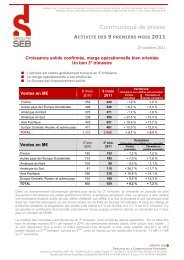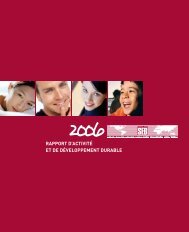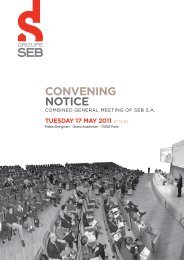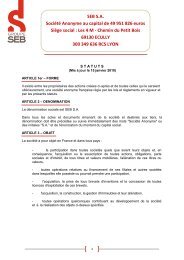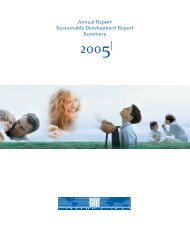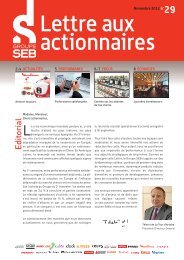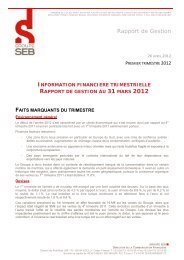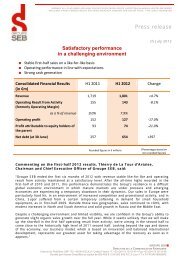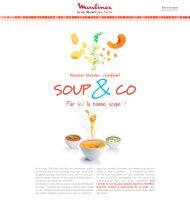financial report and registration document 2011 - Groupe SEB
financial report and registration document 2011 - Groupe SEB
financial report and registration document 2011 - Groupe SEB
You also want an ePaper? Increase the reach of your titles
YUMPU automatically turns print PDFs into web optimized ePapers that Google loves.
4 <strong>2011</strong><br />
Commentary on the fi nancial year<br />
highlights<br />
4.1. <strong>2011</strong> HIGHLIGHTS<br />
General environment<br />
After the economic crisis of 2008-2009, the general context was much<br />
more favourable throughout 2010, characterised by economic recovery<br />
<strong>and</strong> by steady or growing consumer spending levels in most markets,<br />
whether mature or emerging. As a result, the year <strong>2011</strong> opened to a rather<br />
promising global situation, although certain problem areas in the fi rst half of<br />
the year should even be overlooked at the major diffi culties experienced by<br />
many European countries (Greece, Spain, Portugal, etc.), the socio-political<br />
disruption caused by the Arab Spring (while this had little direct impact on<br />
the Group’s business, it did have an indirect effect, especially in relation<br />
to oil prices) <strong>and</strong> the natural <strong>and</strong> industrial disasters in Japan. From the<br />
third quarter onwards, the macroeconomic climate became noticeably less<br />
stable, affected by a series of new concerns <strong>and</strong> grim indicators, such as<br />
the severe downturn of the situation in European countries dealing with<br />
the economic crisis, the general sluggishness of the US economy <strong>and</strong><br />
the downgrading of its credit rating by Moody’s <strong>and</strong> St<strong>and</strong>ard & Poor’s,<br />
rumours of a slowdown in China, etc. This gloomy news <strong>and</strong> the austerity<br />
measures imposed resulted in a high level of pessimism <strong>and</strong> a sharp drop<br />
in household confi dence in the mature markets mentioned above, not to<br />
mention a signifi cant decrease in consumer spending. The situation was<br />
less troubled in other countries, but dem<strong>and</strong> dipped somewhat in Western<br />
Europe, while momentum remained strong in the emerging economies. On<br />
the whole, this trend continued in the fourth quarter, yet it should be noted<br />
that US consumer spending experienced a rebound beginning with Black<br />
Friday <strong>and</strong> around the Christmas holiday.<br />
Currencies<br />
The volatility prevalent over recent years persisted. While 2008 <strong>and</strong> 2009<br />
were characterised by a negative currency impact on sales (-€69 million<br />
in 2008 <strong>and</strong> -€63 million in 2009) due to the marked depreciation of<br />
numerous currencies in relation to the euro, 2010 was just the opposite<br />
with a +€170 million currency impact on sales, due to the rallying of these<br />
same currencies against the euro, especially during the second half of the<br />
year. This trend continued during the fi rst quarter of <strong>2011</strong>, before making<br />
a sudden U-turn during the second quarter <strong>and</strong> continuing in this direction<br />
until the end of the year. Ultimately, the currency effect on <strong>2011</strong> sales st<strong>and</strong>s<br />
at -€26 million. This amount is the result of a mix of fl uctuations depending<br />
on currency <strong>and</strong> period of the year. Based on the average exchange rates<br />
for <strong>2011</strong> compared to 2010, most currencies weakened in relation to the<br />
euro: this is the case, namely, for the Turkish lira (-14.5%, with a steeper<br />
decline during the second half of the year), the Ukrainian hryvnia (-6.7%),<br />
the Mexican peso (-3.1%), the Polish zloty (-3%) <strong>and</strong>, to a lesser extent,<br />
the rouble, the pound sterling <strong>and</strong> the Korean won (ranging between -1.5%<br />
<strong>and</strong> -0.6%). The US dollar (-4.7% for the year in relation to the euro) <strong>and</strong><br />
Under these circumstances, the small domestic equipment market<br />
experienced a brisk first half, thanks in large part to dem<strong>and</strong> from the<br />
emerging economies, followed by softer growth beginning in the summer,<br />
amplifi ed by the downturn seen in Europe during the last four months.<br />
Ultimately, the market fi nished the year <strong>2011</strong> on the rise, although this growth<br />
has slowed as the months have progressed. In terms of quality, it is apparent<br />
that the strained economic context (a repeat of 2008-2009) is refl ected in<br />
consumer buying behaviour, which tends towards low-price products <strong>and</strong><br />
discounts. This situation results in heightened competition, with competition<br />
between industry players being intensifi ed by the competition between retail<br />
distributors.<br />
As for the retail distribution industry, after the diffi culties encountered in<br />
2008-2009, the reforms <strong>and</strong> “st<strong>and</strong>ardisation” in <strong>2011</strong> made it possible to<br />
address <strong>2011</strong> from a calmer perspective. Nevertheless, certain retailers<br />
remain in a precarious position, <strong>and</strong> most clients manage stock levels with<br />
extreme care, throughout the world. Despite a few cases of bankruptcy <strong>and</strong><br />
store closures – either confi rmed or anticipated – <strong>2011</strong> was not affected by<br />
any major incidents, thanks to a judiciously managed commercial policy <strong>and</strong><br />
high credit insurance levels.<br />
the Chinese yuan (-0.2% for the year in relation to the euro) both followed<br />
a rather mixed path depending on the quarter. They started the year on the<br />
rise, then weakened for two quarters, before abruptly resuming an upward<br />
trend during the last three months of the year. Regarding the Brazilian real,<br />
after almost two years of continued appreciation, including the fi rst quarter<br />
of <strong>2011</strong>, it slowed its pace beginning in the spring <strong>and</strong> continued downwards<br />
until the end of the year, ending at a rate almost unchanged for the 12-month<br />
period. Despite a few hiccups, the yen grew 4.9% against the euro in terms<br />
of average exchange rate in <strong>2011</strong> <strong>and</strong> 2010. Amongst all of these currencies,<br />
the two that had the greatest negative effect on <strong>2011</strong> sales were the Turkish<br />
lira <strong>and</strong> the US dollar; however, the weakening of the dollar did have a<br />
positive impact on the Group’s purchases.<br />
The persistent volatility affecting exchange rates over the past few years<br />
is disruptive – sometimes having a positive effect <strong>and</strong> sometimes having<br />
an adverse effect – on the Group’s highly international operations. Despite<br />
this uncertainly, the Group makes every effort to turn a profi t everywhere it<br />
does business.<br />
60 GROUPE <strong>SEB</strong> Financial Report <strong>and</strong> Registration Document <strong>2011</strong>



